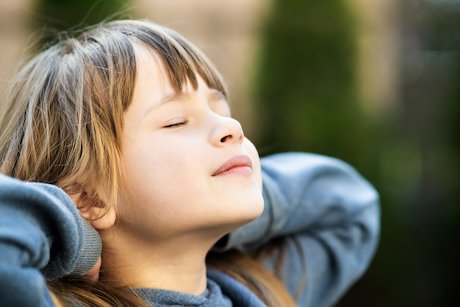Mindfulness
Add to My Folder
The concept of mindfulness can seem a bit wishy-washy when it’s discussed in the media, but it’s really a great way to create a harmonious atmosphere in your classroom. Rosie Huckle’s practical activities show us how to instil a sense of calm and imagination in our children.
In today’s often over-stimulating, multi-media world, it seems more important than ever that we equip children with the skills they need to achieve a sense of stillness and calm. Practising mindfulness is all about learning to pay attention to the present moment, while calmly acknowledging and accepting feelings, thoughts and bodily sensations. It can lead to improved focus and concentration, increased empathy and ability to resolve conflict, as well as reduced anxiety – in short, happier and more positive classrooms! Here is a selection of ideas to get you and your class started on your mindfulness journey.

Awareness of the breath
When you focus on your breath, you are totally in the present moment, which helps to calm the constant chatter of the mind. With regular practice children will find they can access this relaxed state more quickly, so can use the technique whenever they start to feel anxious, frustrated or angry.
Introduce a mindful breathing session as part of the daily classroom routine. You can download a script or audio recording (see resources section below), or just follow this process:
- Invite children to sit comfortably in their chairs, with a straight back but relaxed shoulders, legs uncrossed, feet flat on the ground and hands gently resting on the knees.
- With their eyes open, they should look straight ahead with the gaze soft, starting to notice the sensations of breathing in the body – the rising and falling of the chest and the feeling of the air flowing in and out through the nose and mouth.
- Ask them to begin noticing the various sensations in the body, for example whether they feel warm or cool, tense or relaxed, the chair pushing against their back or the feel of the floor beneath their feet.

- They should now slowly close their eyes, continuing to focus solely on the experience of breathing, feeling more and more relaxed with each out breath.
- Explain that as you try and concentrate on your breathing alone, it is totally normal for thoughts, feelings and physical sensations to push their way in.
- When children notice that their mind has wandered away from the breath, encourage them to just bring it gently back. They could visualise each thought as a bubble floating past – they can watch it go without getting involved. Mindfulness is therefore not simply about ‘not doing’, but is an active process of constantly refocusing the attention.
Already a member? Sign in below.
Published 18 February 2016
Reviews
You need to be signed in to place a review.

